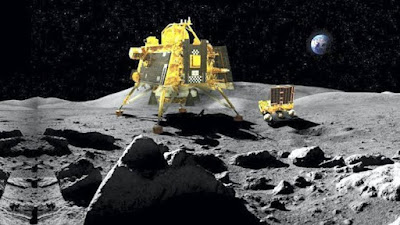Chandrayaan-3
Chandrayaan-3: India's Quest for Lunar Exploration Continues
Space exploration has always captured the imagination of humanity, and India has been at the forefront of this endeavor with its Chandrayaan missions. Building upon the success of Chandrayaan-1 and Chandrayaan-2, the Indian Space Research Organisation (ISRO) embarked on Chandrayaan-3, the country's ambitious lunar mission. In this blog, we will delve into the details of Chandrayaan-3 and its remarkable journey.
Chandrayaan-3:
The Mission's Purpose:
Chandrayaan-3 is an unmanned lunar exploration mission aimed at further enhancing India's scientific knowledge and understanding of the Moon. The primary objectives of the mission are to demonstrate India's technological prowess, study the lunar surface, and conduct experiments to unravel the Moon's mysteries.
Mission Components and Payloads:
Similar to its predecessor, Chandrayaan-2, Chandrayaan-3 comprises an orbiter, a lander, and a rover. The orbiter serves as the communication link between the mission control and the lander-rover module, while the lander houses the rover and facilitates its descent onto the lunar surface.
The Chandrayaan-3 lander carries a suite of scientific payloads to conduct various experiments on the Moon. These payloads are designed to analyze the lunar soil, study the composition of the lunar surface, and investigate the presence of volatiles and water molecules.
Journey Timeline:
1. Launch:
Chandrayaan-3 is expected to be launched atop ISRO's Geosynchronous Satellite Launch Vehicle (GSLV) Mk III. The powerful GSLV Mk III launch vehicle will propel the spacecraft into the Earth's orbit, from where it will commence its journey towards the Moon.
1. Lunar Orbit Insertion:
After traversing the vast expanse of space, Chandrayaan-3 will enter the Moon's sphere of influence. The spacecraft will perform a series of complex maneuvers to achieve Lunar Orbit Insertion (LOI), wherein it will be captured by the Moon's gravitational pull.
1. Soft Landing:
Once in lunar orbit, the lander will detach from the orbiter and initiate its descent towards the lunar surface. The lander's engines will fire to slow down its descent, enabling a soft landing in the designated landing site. This phase is crucial and demands precision to ensure a safe touchdown.
1. Rover Deployment and Surface Operations:
Upon successful landing, the lander will deploy the rover onto the lunar surface. The rover, equipped with advanced scientific instruments, will commence its exploration and data collection activities. It will traverse the lunar terrain, analyzing the soil composition and investigating the presence of water molecules.
Significance and Future Prospects:
Chandrayaan-3 holds immense significance for India's space program and scientific community. The mission aims to build upon the valuable data obtained from Chandrayaan-1 and Chandrayaan-2, thereby deepening our understanding of the Moon's geological evolution, its resources, and the potential for future human missions.
Additionally, Chandrayaan-3 is a testament to India's indigenous technological capabilities. The mission incorporates cutting-edge technologies developed by Indian scientists and engineers, showcasing the nation's self-reliance in space exploration.
Chandrayaan-3 represents India's unwavering commitment to space exploration and scientific discovery. With its ambitious objectives and advanced payloads, the mission is poised to unlock new insights into the Moon's mysteries. As Chandrayaan-3 embarks on its journey, we eagerly await the scientific discoveries and technological advancements that will propel India's space program to greater heights.



Comments
Post a Comment